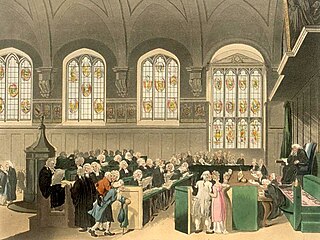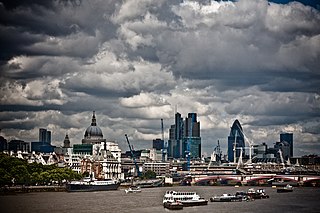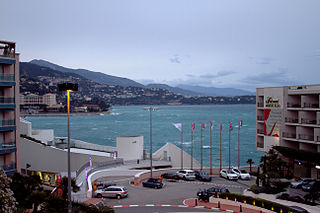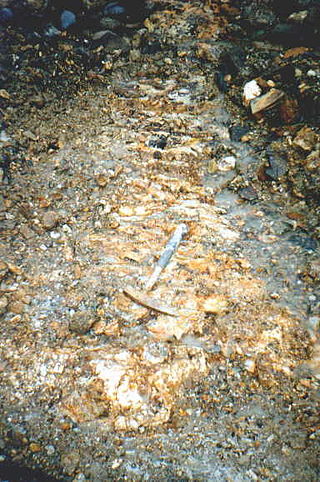In finance, a floating charge is a security interest over a fund of changing assets of a company or other legal person. Unlike a fixed charge, which is created over ascertained and definite property, a floating charge is created over property of an ambulatory and shifting nature, such as receivables and stock.

Tracing is a legal process, not a remedy, by which a claimant demonstrates what has happened to his/her property, identifies its proceeds and those persons who have handled or received them, and asks the court to award a proprietary remedy in respect of the property, or an asset substituted for the original property or its proceeds. Tracing allows transmission of legal claims from the original assets to either the proceeds of sale of the assets or new substituted assets.

Barclays Bank Ltd v Quistclose Investments Ltd[1968] UKHL 4 is a leading property, unjust enrichment and trusts case, which invented a new species of proprietary interest in English law. A "Quistclose trust" arises when an asset is given to somebody for a specific purpose and if, for whatever reason, the purpose for the transfer fails, the transferor may take back the asset.
Devaynes v Noble (1816) 35 ER 781, best known for the claim contained in Clayton's case, created a rule, or more precisely common law presumption, in relation to the distribution of money from a bank account. The rule is based upon the deceptively simple notion of first-in, first-out to determine the effect of payments from an account, and normally applies in English Law in the absence of evidence of any other intention. Payments are presumed to be appropriated to debts in the order in which the debts are incurred.

English trust law concerns the protection of assets, usually when they are held by one party for another's benefit. Trusts were a creation of the English law of property and obligations, and share a subsequent history with countries across the Commonwealth and the United States. Trusts developed when claimants in property disputes were dissatisfied with the common law courts and petitioned the King for a just and equitable result. On the King's behalf, the Lord Chancellor developed a parallel justice system in the Court of Chancery, commonly referred as equity. Historically, trusts have mostly been used where people have left money in a will, or created family settlements, charities, or some types of business venture. After the Judicature Act 1873, England's courts of equity and common law were merged, and equitable principles took precedence. Today, trusts play an important role in financial investment, especially in unit trusts and in pension trusts. Although people are generally free to set the terms of trusts in any way they like, there is a growing body of legislation to protect beneficiaries or regulate the trust relationship, including the Trustee Act 1925, Trustee Investments Act 1961, Recognition of Trusts Act 1987, Financial Services and Markets Act 2000, Trustee Act 2000, Pensions Act 1995, Pensions Act 2004 and Charities Act 2011.

United Kingdom insolvency law regulates companies in the United Kingdom which are unable to repay their debts. While UK bankruptcy law concerns the rules for natural persons, the term insolvency is generally used for companies formed under the Companies Act 2006. Insolvency means being unable to pay debts. Since the Cork Report of 1982, the modern policy of UK insolvency law has been to attempt to rescue a company that is in difficulty, to minimise losses and fairly distribute the burdens between the community, employees, creditors and other stakeholders that result from enterprise failure. If a company cannot be saved it is liquidated, meaning that the assets are sold off to repay creditors according to their priority. The main sources of law include the Insolvency Act 1986, the Insolvency Rules 1986, the Company Directors Disqualification Act 1986, the Employment Rights Act 1996 Part XII, the EU Insolvency Regulation, and case law. Numerous other Acts, statutory instruments and cases relating to labour, banking, property and conflicts of laws also shape the subject.
The English law of unjust enrichment is part of the English law of obligations, along with the law of contract, tort, and trusts. The law of unjust enrichment deals with circumstances in which one person is required to make restitution of a benefit acquired at the expense of another in circumstances which are unjust.

Bishopsgate Investment Management Ltd v Maxwell [1993] BCLC 814 is a UK company law case concerning a director's duty to act for proper purposes of the company. This case is an example of what would now be Companies Act 2006, section 171.
Tracing is a procedure in English law used to identify property which has been taken from the claimant involuntarily or which the claimant wishes to recover. It is not in itself a way to recover the property, but rather to identify it so that the courts can decide what remedy to apply. The procedure is used in several situations, broadly demarcated by whether the property has been transferred because of theft, breach of trust, or mistake.

The Attorney General for Hong Kong v Reid (UKPC)[1993] UKPC 2 was a New Zealand-originated trust law case heard and decided by the Judicial Committee of the Privy Council, where it was held that bribe money accepted by a person in a position of trust, can be traced into any property bought and is held on constructive trust for the beneficiary.

Westdeutsche Landesbank Girozentrale v Islington LBC[1996] UKHL 12, [1996] AC 669 is a leading English trusts law case concerning the circumstances under which a resulting trust arises. It held that such a trust must be intended, or must be able to be presumed to have been intended. In the view of the majority of the House of Lords, presumed intention to reflect what is conscionable underlies all resulting and constructive trusts.

Oldham v Kyrris[2003] EWCA Civ 1506 is a UK insolvency law case concerning the administration procedure when a company is unable to repay its debts.

Foskett v McKeown[2000] UKHL 29 is a leading case on the English law of trusts, concerning tracing and the availability of proprietary relief following a breach of trust.
Vaughan v Barlow Clowes International Ltd [1991] EWCA Civ 11 is an English trusts law case, concerning tracing.

Re Hallett’s Estate (1880) 13 Ch D 696 is an English trusts law case, concerning asset tracing.

Sir Andrew Peter Leggatt, PC was a British judge who served as the Lord Justice of Appeal and as a member of the Privy Council. He was noted for his acerbic wit and precise, well-written judgements. As a barrister, his clients included Paul McCartney and Robert Bolt.

FHR European Ventures LLP v Cedar Capital Partners LLC[2014] UKSC 45 is a landmark decision of the United Kingdom Supreme Court which holds that a bribe or secret commission accepted by an agent is held on trust for his principal. In so ruling, the Court partially overruled Sinclair Investments (UK) Ltd v Versailles Trade Finance Ltd in favour of The Attorney General for Hong Kong v Reid (UKPC), a ruling from the Judicial Committee of the Privy Council on appeal from New Zealand.

Sir George Brian Hugh Dillon, PC was a British lawyer and judge who served as a Lord Justice of Appeal from 1982 to 1994.
Sir Denis Robert Maurice Henry, PC was an English barrister, Queen's Counsel and judge, rising to Lord Justice of Appeal. He presided over the Guinness share-trading fraud trial, a major British business scandal of the 1980s.

Re Nanwa Gold Mines Ltd [1955] 1 WLR 880 was a trust law decision relating to subscription monies for shares and what would subsequently come to be known as Quistclose trusts. The court held that where subscription monies had been paid over to enable the company to accomplish a specific purpose, if that purpose failed then the money was held on trust for the subscribers and did not form part of the assets of the company. Even though the decision was only a first-instance ex tempore decision, it has been repeatedly upheld, including by the House of Lords in Barclays Bank Ltd v Quistclose Investments Ltd[1968] UKHL 4














